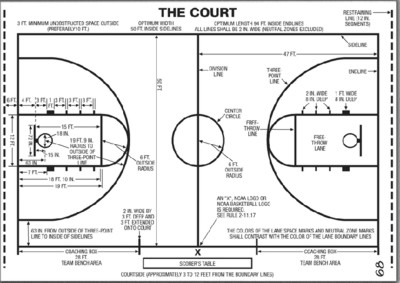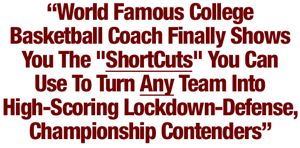What are a basketball coaches court diagrams? They are the somewhat secret code between the coach and players on what they need to do on the court.
Okay, they’re not really secret. Well, not for anyone who has played competitive basketball before.
But, basketball coaches court diagrams are the best way to communicate effectively both with words and visually.
The coach can knock out two birds with one stone, instructing his or her team with words, while he or she breaks down the play or defensive assignment on a whiteboard. Basketball coaches court diagrams are usually placed on a dry-erase whiteboard. The whiteboard looks like a bird-eye’s view of the basketball court.

It’s made out of dry-erase whiteboard so the coach can quickly erase what he or she is drawing and prepare the board for the next diagram.
Basketball coaches court diagrams include the full court, one hoop on the top and another hoop on the bottom of the whiteboard. Distinguishable features like the key, free-throw line, and three-point line are printed on the diagram. Last but not least, the diagram includes out of bounds lines and the half-court line.
When basketball coaches begin drawing a diagram on the court, they first start with the offense. The offense should be labeled by a small “O” at the position the offensive player will start standing at. Include four other “O’s” on the diagram to create the five other offensive players.
Now are you drawing up an offensive play or defensive formation?
Let’s start with defense…
The offensive players do not need to be specific.
Say you are running a 2-3 Zone and the offensive player on the baseline keeps killing your team with easy offensive baskets. The problem you see is the player drives hard to the paint when the ball is on the other side of the court. The weak side defender is not keeping both ball and man in check, allowing the offensive player to cut hard to the paint and receive and open pass from his teammate.
Set up the offensive formation they generally are in. Next draw the five defensive players with “X’s.” If it’s a 2-3 Zone, you will obviously draw two “X’s” on top and three “X’s” horizontal with the baseline.
Circle the defensive player on the far baseline who keeps losing track of his man. Then circle the offensive player on his side who keeps cutting easy to the hoop. When you circle certain positions or players, you are forcing attention on those objects.
The players will react better. Some coaches even go as far as listing the number of the player instead of an “O” to add extra attention to that player. Whatever you think works, just make sure you address the problem effectively through communication and visually with the basketball court diagram.
For offense, coaches use basketball diagrams much more frequently before tip-off, during timeouts, and at half-time.
While poor defense usually comes down to a lack of effort or attention to detail, offense is something that really requires perfect execution and movement by all five players. Diagram certain plays that are not working and explain why they are not working. Perhaps the center is running up to the three-point line to fast to set the pick for the point guard? Maybe the off-ball swingman isn’t cutting to the hoop fast enough? Is the point guard holding onto the ball too long?
Whatever the issue, address it and fix it immediately.
Sometimes during end-of-the-game situations, the coach will call a timeout and install a new play the team hasn’t run all year. You want to do this once and awhile because you’ve noticed something throughout the course of the game that will work or the defense is weak at. It’s also nice to install a fresh play, because the opponent has probably seen you run all your plays at least once throughout the game.
General rules when installing a new play at the end of the game is quick and precise communication, as you only have a half-to-full minute to teach the play. Also coaches usually will place the ball in the hands of the player who is having the best offensive game or attempt to get that player the ball off a screen.
Return from Basketball Coaches Court Diagrams to Basketball Coaches
Return from Basketball Coaches Court Diagrams to Best Basketball Tips



